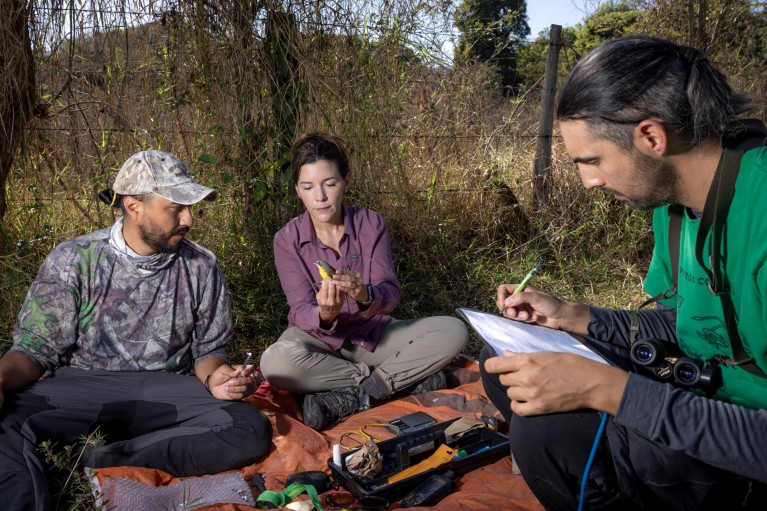Hello Nature readers, would you like to get this Briefing in your inbox free every day? Sign up here.

Pando consists of a vast root system with nearly 50,000 cloned stems, spread over an area of more than 40 hectares.Credit: George Rose/Getty
DNA from ‘Pando’ — a vast forest made up of a single root system sprouting nearly 50,000 cloned quaking aspen trees — seems to confirm that it is one of the oldest organisms on Earth. Researchers sequenced hundreds of samples from the Populus tremuloides and found that it is between 16,000 and 80,000 years old. They were also able to track patterns of genetic variation spread throughout the tree, offering clues about how it has adapted and evolved over the course of its lifetime.
Reference: bioRxiv preprint (not peer reviewed)
A sugary diet in the first two years of a child’s life is linked to a higher risk of diabetes and high blood pressure in adulthood. An analysis of 1950s sugar rationing in the United Kingdom showed that the amount of sugar a child consumed after turning six months old had the biggest effect on diabetes risk. Those exposed to more sugar in the womb also had a higher risk compared to those who were conceived when sugar was rationed. The results don’t necessarily mean that parents should eliminate all added sugars, says economist and co-author Tadeja Gračner. But there could be room to cut back: in the United States, pregnant and lactating people typically eat more than three times the recommended amount.
Dusky lory parrots (Pseudeos fuscata) have a unique genetic change that allows them to sport a rainbow of colours. Pigments in their feathers called psittacofulvins, which are only found in parrots, are made up of carbon chains of varying lengths. These chains have an aldehyde group at one end by default when they’re synthesized, which makes the pigment red. Researchers found a gene in the dusky lory’s genome that encodes an enzyme that can modify the aldehyde into a carboxyl group, which changes the pigment’s colour to yellow. “Nature often uses elegantly simple reactions to achieve significant change,” says chemist Keith Gordon.
Features & opinion
Psychologist Sander van der Linden believes that there’s a dangerous infection spreading globally — misinformation. He also has a way to combat it: ‘inoculating’ people against misinformation to stop them from believing and spreading it, in an approach analogous to vaccinating against viral infections. The concept of ‘prebunking’ involves first warning people that they might be intentionally misled, then showing them a mild form of misinformation. There is evidence that the approach can lessen the persuasiveness of falsities, but critics argue that the method places the onus on the individual and absolves social media companies that might profit from spreading lies.
Early excitement about the GLP-1 hormone, which underpins the blockbuster drugs Ozempic and Wegovy, fizzled out when drug developers struggled to overcome the peptide’s minutes-long half-life. “They all ran away,” recalls Lotte Bjerre Knudsen, now a chief scientific advisor at pharma behemoth Novo Nordisk. Tasked with a last attempt at bringing the hormone to heel, Knudsen turned to a protein-engineering ‘fatty acid acylation’ strategy to extend its half-life, inventing the once-daily GLP-1 analogue liraglutide. Thirty years later, Novo’s once-weekly GLP-1 analogue semaglutide is a medical and commercial phenomenon, with sales of over US$18 billion last year in diabetes and obesity.
Nature Reviews Drug Discovery | 9 min read
With the US presidential election taking place this week, we’re resharing Nature’s three-part podcast series explaining why we, as a science magazine and journal, cover politics when necessary. The series explains how politics impacts the working life of a scientist, influencing the quality and direction of research, and therefore, why Nature can’t just “stick to the science”.
Nature | 3-part podcast series
Where I work

Ana Gonzalez is a protected-areas analyst for the Canadian Wildlife Service in Delta, British Columbia.Credit: Ugo Mellone
In Asunción Atoyaquillo, Mexico, protected-areas analyst Ana Gonzalez and her colleagues tag a yellow-breasted chat (Icteria virens) to track its movements during migration and at its wintering grounds. “One thing I love about this photo is that it shows that I don’t work alone,” she says. “Sergio is holding a radio transmitter in a pair of tweezers, while Adrián is recording data. Could I do this work by myself? Probably, but it’s a lot easier when you have partners.” (Nature | 3 min read)
On Friday, Leif Penguinson was taking in the sights of Dunure Castle on the West coast of Scotland. Did you find the penguin? When you’re ready, here’s the answer.
Thanks for reading,
Flora Graham, senior editor, Nature Briefing
With contributions by Jacob Smith
Want more? Sign up to our other free Nature Briefing newsletters:
• Nature Briefing: Careers — insights, advice and award-winning journalism to help you optimize your working life
• Nature Briefing: Microbiology — the most abundant living entities on our planet — microorganisms — and the role they play in health, the environment and food systems
• Nature Briefing: Anthropocene — climate change, biodiversity, sustainability and geoengineering
• Nature Briefing: AI & Robotics — 100% written by humans, of course
• Nature Briefing: Cancer — a weekly newsletter written with cancer researchers in mind
• Nature Briefing: Translational Research — covers biotechnology, drug discovery and pharma
